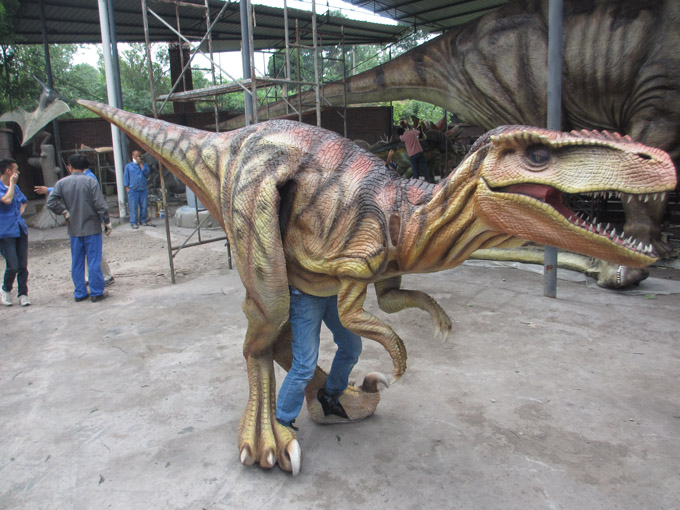- Tel: +86 813 2105845
- Fax: +86 813 2105845
- Mob: +86 13778532392
- Contact: Mr. Jacky
 info@dinosaurs-world.com
info@dinosaurs-world.com Jackydinosworld@gmail.com
Jackydinosworld@gmail.com Jackyyiming@gmail.com
Jackyyiming@gmail.com Jackyzengdinosaursworld
Jackyzengdinosaursworld
- Predatory Dinosaurs Had 'Splendid Suite' of Healing Powers

Scientists studying the bones of a meat-eating dinosaur that lived about 150 million years ago have discovered the carnivorous creature had extraordinary powers to heal itself.
For their study, a research team from the University of Manchester in England researchers used synchrotron-imaging -- a state-of-the-art scanning technique -- to examine the cracks, fractures and breaks in the bones of a predatory Allosaurus.
The work, say the scientists, has set a completely new level for understanding the healing process that took place when the great creatures walked the earth.
Published in the Royal Society journal Interface, the new study was based on the fact dinosaur bones sometimes preserve evidence of trauma and sickness, as well as indicators of healing.Synchrotron-based imaging, which uses light brighter than 10 billion Suns, allowed the researchers to clearly inspect the residual chemical evidence of the creature's life experiences preserved in its bones.
Such fossil examinations previously relied on the painstaking inspection of mangled bones and healed fractures, and often required slicing through a specimen to decipher its story.
"Using synchrotron imaging, we were able to detect astoundingly dilute traces of chemical signatures that reveal not only the difference between normal and healed bone, but also how the damaged bone healed," Phil Manning, one of the paper's authors from Manchester's School of Earth, Atmospheric and Environmental Sciences, said in a news release. "It seems dinosaurs evolved a splendid suite of defense mechanisms to help regulate the healing and repair of injuries. The ability to diagnose such processes some 150 million years later might well shed new light on how we can use Jurassic chemistry in the 21st Century."
The disruptive effects scientists assume an animal would suffer from massive trauma seemed to be all but shrugged off by many predatory dinosaurs, with fossil bones exhibiting an array of gruesome healed injuries --- most of which likely would prove deadly to a human, if not treated by a physician.
"Bone does not form scar tissue, like a scratch to your skin, so the body has to completely reform new bone following the same stages that occurred as the skeleton grew in the first place. This means we are able to tease out the chemistry of bone development through such pathological studies," said study co-author Jennifer Anné. "It's exciting to realize how little we know about bone, even after hundreds of years of research. "
Roy Wogelius, another co-author of the research and Manchester professor, suggested there's a "fine line" when trying to figure out which part of the fossil was re-positioned after burial and what was original chemistry to the organism.
"It is only through the precise measurements that we undertake at the Diamond [synchrotron radiation] Lightsource in the U.K. and the Stanford Synchrotron Lightsource in the U.S. that we were able to make such judgments."
Said Manning: "The chemistry of life leaves clues throughout our bodies in the course of our lives that can help us diagnose, treat and heal a multitude of modern-day ailments. It's remarkable that the very same chemistry that initiates the healing of bone in humans also seems to have followed a similar pathway in dinosaurs."

 2014-05-08
2014-05-08
 New dinosaur species help scientists fill in evolutionary gaps
New dinosaur species help scientists fill in evolutionary gaps Feathered everything: just how many dinosaurs had feathers?
Feathered everything: just how many dinosaurs had feathers? Dinosaur Fossil With Fleshy Rooster's Comb Is First of Its Kind
Dinosaur Fossil With Fleshy Rooster's Comb Is First of Its Kind Scientists finally decode how dinosaurs turned into birds and learned how to fly
Scientists finally decode how dinosaurs turned into birds and learned how to fly Dark matter may have killed the dinosaurs, claims scientist
Dark matter may have killed the dinosaurs, claims scientist New duck-billed dinosaur uncovered in Alaska, researchers say
New duck-billed dinosaur uncovered in Alaska, researchers say
- Contact Us
- Tel: +86 813 2105845
- Fax: +86 813 2105845
- Contact: Mr. Jacky
 info@dinosaurs-world.com
info@dinosaurs-world.com Jackydinosworld@gmail.com
Jackydinosworld@gmail.com Jackyyiming@gmail.com
Jackyyiming@gmail.com Jackyzengdinosaursworld
Jackyzengdinosaursworld
- Copyright @ 2009 - 2020 Zigong Dinosaurs World Science & Technology Co.,Ltd.

